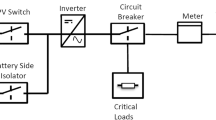Abstract
The grid energy storage systems, particularly renewable energy storage, are increasingly becoming more common. Thus, identifying and evaluating possible hazards and consequences are of utmost priority. This paper focuses on five energy storage systems, compressed air energy storage system, liquid air energy storage system, thermal energy storage in concentrated solar power plant, lithium-ion battery and flywheel energy storage system. The description of these systems is followed by a fundamental event tree analysis of a single most hazardous initiating event within the system. The installed safety barriers are assumed for event tree analysis based on relevant data and consequences analyzed. The failure on-demand and reliability are the two pathways for each installed safety barrier system. The analysis provides insight into worst-case scenarios and guides designers in considering the inherently safer design and redundant safety installations. However, further research is needed for accurate probabilistic calculation results based on actual failure on-demand rates obtained from industry-specific data of these instruments.












Similar content being viewed by others
References
U. Shahzad, The need for renewable energy sources. Energy. 2, 16–18 (2012)
R. L. Ottinger, R. Williams (2002) “Renewable energy sources for development,” Environ. Law, pp. 331–368
R. Wüstenhagen, M. Wolsink, M.J. Bürer, Social acceptance of renewable energy innovation: an introduction to the concept. Energy Policy. 35(5), 2683–2691 (2007)
Y. Atalay, F. Biermann, A. Kalfagianni, Adoption of renewable energy technologies in oil-rich countries: explaining policy variation in the Gulf cooperation council states. Renew. Energy. 85, 206–214 (2016)
B. Diouf, R. Pode, Potential of lithium-ion batteries in renewable energy. Renew. Energy. 76, 375–380 (2015)
D. Gielen, F. Boshell, D. Saygin, M.D. Bazilian, N. Wagner, R. Gorini, The role of renewable energy in the global energy transformation. Energy Strateg. Rev. 24, 38–50 (2019). https://doi.org/10.1016/J.ESR.2019.01.006
M.S. Guney, Y. Tepe, Classification and assessment of energy storage systems. Renew. Sustain. Energy Rev. 75(November), 1187–1197 (2017). https://doi.org/10.1016/j.rser.2016.11.102
“Homepage - U.S. Energy Information Administration (EIA).” https://www.eia.gov/ (accessed May 24, 2022).
“Electrical Energy Storage - an overview | ScienceDirect Topics.” https://www.sciencedirect.com/topics/materials-science/electrical-energy-storage (accessed May 24, 2022)
“International Energy Outlook Consumption - Liquid fuels remain the largest energy source in the Reference case, but renewable energy use grows to nearly the same level - U.S. Energy Information Administration (EIA).” https://www.eia.gov/outlooks/ieo/consumption/sub-topic-01.php (accessed May 24, 2022).
“Energy Storage – Analysis - IEA.”
M.T. Lawder et al., Battery energy storage system (BESS) and battery management system (BMS) for grid-scale applications. Proc. IEEE. 102(6), 1014–1030 (2014). https://doi.org/10.1109/JPROC.2014.2317451
M. Kleinberg et al., Energy storage valuation under different storage forms and functions in transmission and distribution applications. Proc. IEEE. 102(7), 1073–1083 (2014). https://doi.org/10.1109/JPROC.2014.2324995
F. Rahman, S. Rehman, M.A. Abdul-Majeed, Overview of energy storage systems for storing electricity from renewable energy sources in Saudi Arabia. Renew. Sustain. Energy Rev. 16(1), 274–283 (2012). https://doi.org/10.1016/j.rser.2011.07.153
K. Zaghib, A. Mauger, C.M. Julien, Rechargeable lithium batteries for energy storage in smart grids. (Elsevier, Armsterdam, 2015)
T. Chen et al., Applications of lithium-ion batteries in grid-scale energy storage systems. Trans. Tianjin Univ. 26(3), 208–217 (2020). https://doi.org/10.1007/s12209-020-00236-w
D. Rosewater, A. Williams, Analyzing system safety in lithium-ion grid energy storage. J. Power Sour. 300, 460–471 (2015). https://doi.org/10.1016/j.jpowsour.2015.09.068
X. Li, A. Palazzolo, A review of flywheel energy storage systems: state of the art and opportunities. J. Energy Storage. (2021). https://doi.org/10.1016/j.est.2021.103576
G. Newsom, E. G. Brown, “Flywheel Systems for Utility Scale Energy Storage A Transformative Flywheel Project for Commercial Readiness California Energy Commission,” no. January, 2019.
M.E. Amiryar, K.R. Pullen, A review of flywheel energy storage system technologies and their applications. Appl Sci. (2017). https://doi.org/10.3390/app7030286
A.G. Olabi, T. Wilberforce, M. Ramadan, M.A. Abdelkareem, A.H. Alami, Compressed air energy storage systems: components and operating parameters – A review. J. Energy Storage. 34, 102000 (2021). https://doi.org/10.1016/j.est.2020.102000
X. Wen, D. Yang, J. Zhong, T. Feng, X. Li, Research on recovery and utilization of waste heat in advanced compressed air energy storage system. Energy Rep. 8, 1436–1445 (2022). https://doi.org/10.1016/j.egyr.2022.02.082
S. Rajput, N. Sabharwal, A. Singh, B. Shingan, B.P. Yadav, City gas distribution incident analysis in India using Pareto principle: a comprehensive analysis. J. Fail. Anal. Prev. (2022). https://doi.org/10.1007/s11668-022-01422-9
S. Huang, A. Khajepour, A new adiabatic compressed air energy storage system based on a novel compression strategy. Energy. 242, 122883 (2022). https://doi.org/10.1016/j.energy.2021.122883
J.H. Park, J.Y. Heo, J.I. Lee, Techno-economic study of nuclear integrated liquid air energy storage system. Energy Convers. Manag. 251, 114937 (2022). https://doi.org/10.1016/j.enconman.2021.114937
C. Lu, Q. He, S. Cui, X. Shi, D. Du, W. Liu, Evaluation of operation safety of energy release process of liquefied air energy storage system. Energy. 235, 121403 (2021). https://doi.org/10.1016/j.energy.2021.121403
N.B. Desai, M.E. Mondejar, F. Haglind, Techno-economic analysis of two-tank and packed-bed rock thermal energy storages for foil-based concentrating solar collector driven cogeneration plants. Renew. Energy. 186, 814–830 (2022). https://doi.org/10.1016/j.renene.2022.01.043
A. Calderón, C. Barreneche, A.I. Fernández, M. Segarra, Thermal cycling test of solid particles to be used in concentrating solar power plants. Sol. Energy Mater. Sol. Cells. 222, 110936 (2021). https://doi.org/10.1016/j.solmat.2020.110936
B. Hoffschmidt et al., “3.18 - Concentrating Solar Power,” T. M. B. T.-C. R. E. (Second E. Letcher, Ed. Oxford: Elsevier, 2022, pp. 670–724.
“Hazard and Risk: OSH Answers.” https://www.ccohs.ca/oshanswers/hsprograms/hazard_risk.html (accessed May 24, 2022).
B.K. Rout, B.K. Sikdar, Hazard identification, risk assessment, and control measures as an effective tool of occupational health assessment of hazardous process in an iron ore pelletizing industry. Indian J. Occup. Environ. Med. 21(2), 56–76 (2017). https://doi.org/10.4103/ijoem.IJOEM_19_16
E.S. Hong, I.M. Lee, H.S. Shin, S.W. Nam, J.S. Kong, Quantitative risk evaluation based on event tree analysis technique: Application to the design of shield TBM. Tunn. Undergr. Sp. Technol. 24(3), 269–277 (2009). https://doi.org/10.1016/J.TUST.2008.09.004
Author information
Authors and Affiliations
Corresponding author
Additional information
Publisher's Note
Springer Nature remains neutral with regard to jurisdictional claims in published maps and institutional affiliations.
Rights and permissions
About this article
Cite this article
Singh, A.K., Kumar, R.S. & Pusti, A. Consequence Analysis of Most Hazardous Initiating Event in Electrical Energy Storage Systems Using Event Tree Analysis. J Fail. Anal. and Preven. 22, 1646–1656 (2022). https://doi.org/10.1007/s11668-022-01464-z
Received:
Accepted:
Published:
Issue Date:
DOI: https://doi.org/10.1007/s11668-022-01464-z




